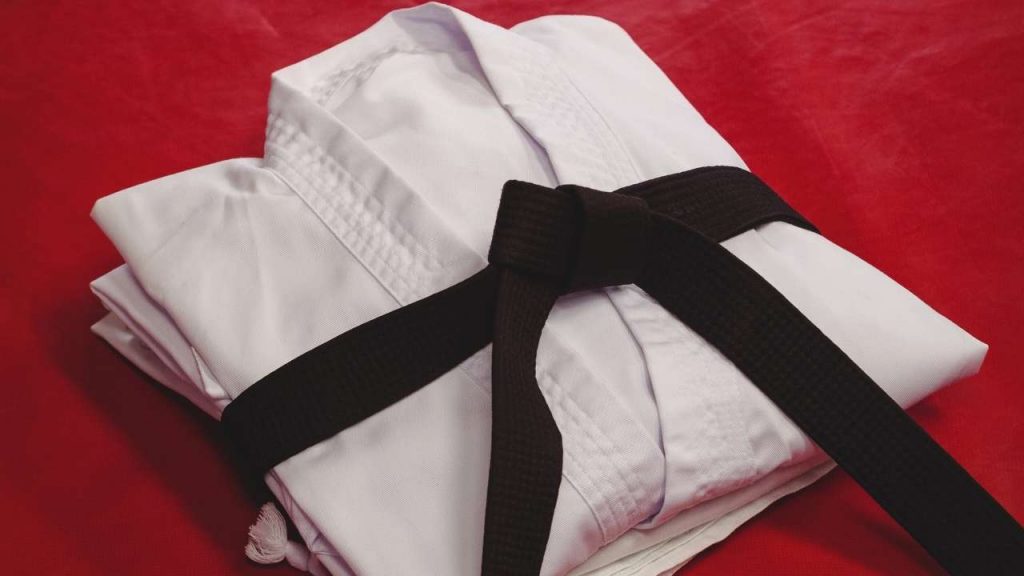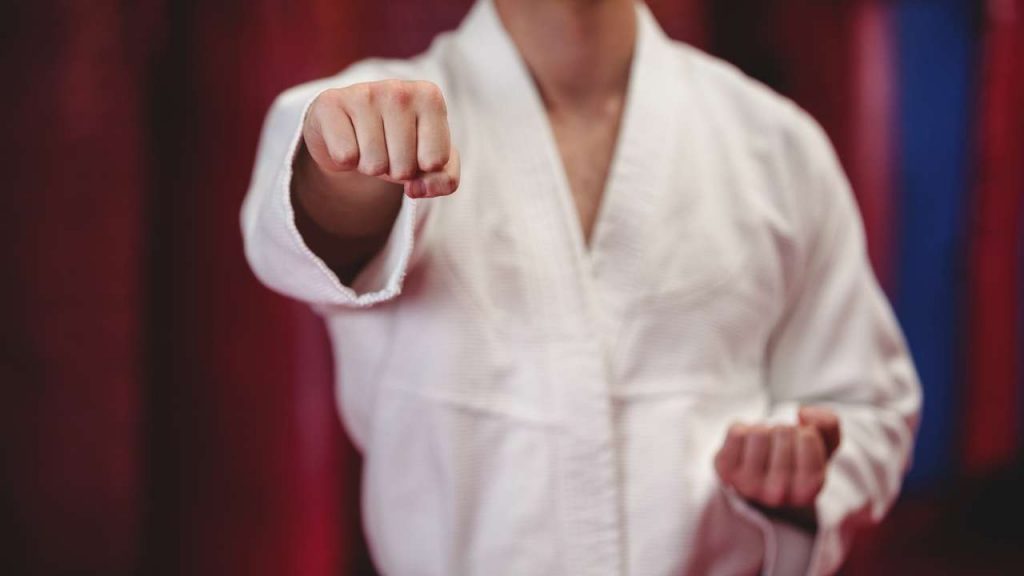If you or someone you know have recently started training in martial arts, you’ve probably heard that practitioners are often required to wear a gi. While many people think of gis as uniforms for training, these pieces of clothing have a much greater significance in the world of martial arts.
Here, I’m going to introduce you to the gi. I’ll do this by detailing everything you need to know about this uniform, including why and when it’s used, the difference between Gi and NoGi, how to properly wear and maintain the gi, and more. Let’s get started!
Table of Contents
What Is a Gi in Martial Arts?
In popular martial arts like judo, karate, Brazilian jiu-jitsu, and aikido, a gi uniform is what practitioners wear during training and/or competitions. The full name of a gi is keikogi, which consists of the Japanese words keiko (meaning practice) and gi (signifying clothes or dress).
According to some traditions, the word keiko can also be switched to the term dō. This indicates that the gi is not used only in practice but is part of the complete martial arts lifestyle.
A gi outfit is typically made of sturdy material like cotton and comes in a variety of colors, including the traditional white one. This unique uniform is also known as practice dress among students; although consisting of a jacket or shirt and pants, it resembles more of a suit than a dress.
Depending on the culture and style, the pants are called zubon or shitabaki (meaning underpants and pants, respectively) and are designed in a way to provide optimal comfort and mobility, often featuring an elastic waistband and a convenient drawstring.
Likewise, the jacket or shirt (called uwagi, which translates as “upper”) is made in a loose fit to be comfortable and allow for a full range of movement. Most gis also have a belt called obi, which completes the look and helps secure tops with a crossover design.

Why Do Martial Artists Wear Gis?
For martial artists, a gi is much more than a simple piece of clothing. As humble as it might look, this uniform has been revered by many generations of practitioners. It symbolizes the age-old tradition of the discipline and martial arts itself and is often associated with discipline and focus.
However, gi is also essential for beginners and advanced practitioners alike for many other reasons. Below are the main benefits of wearing a gi in martial arts.
Equality
When everyone wears the same uniform in class, everyone becomes equal regardless of gender, age, wealth, and experience level. Besides providing a sense of equality, wearing the same clothes also allows for a positive and motivating environment.
Organization
At the same time, when different ranks are practicing or competing during the same competition, gis can help keep things organized. The different colors and patches allow you to see which rank each person is with a simple glance.
Discipline and Commitment
Wearing a gi is a reminder that you must approach the sport and your opponent with the utmost respect.
Putting on the gi before class is a particularly great reminder for young students to adopt a disciplined state of mind, enabling them to focus on their training. When practitioners wear a gi, they become more committed to the art form they are practicing.
Tradition
Donning a gi helps connect contemporary practitioners with the ancient traditions and the generations of ancestors who practiced the arts before them. In many cultures, martial arts and gi wearing are used for passing down ancient traditions and a piece of history.
Functionality
A gi is designed as a functional garment optimized for martial arts training. Its sturdy material ensures it withstands straining and wear and tear, which comes with vigorous training, while its slightly loose fit provides practitioners with a full range of motions to execute their moves.
The longer you can be comfortable wearing a uniform, the longer you can remain focused on training.
Perfecting the Technique
While practicing a martial art, you’ll learn a broad range of techniques varying in difficulty. Wearing comfortable clothing like a gi helps you focus and perfect each of them, so you can learn how to hold a position, escape holds, attack, and much more.
It’s much easier to concentrate on how to enhance your technique and advance in martial arts if you do not have to deal with distractions. These can include the possibility of your clothes tearing (in the case of tight gym clothes) or dragging around unnecessary loads (in the case of impractical, baggy clothes).
Change of Mindset
Wearing a gi transports you into a new place, which is different from every other you frequent during your life.
This is a place where you train and where you can (and must) let go of your worries, as opposed to, for example, the place where you live or work and are surrounded by the stress of day-to-day life. Putting on that gi is an easy way to make that switch from being a regular person to a martial artist.
Which Martial Arts Use Gi?
You’ll notice that many martial arts don’t use the gi. Often, these are non-traditional martial arts. However, you’ll also note that the majority of martial arts that use the gi were founded in Japan, where the garment originates from.
Here are the most popular martial arts that us a gi:
- Brazilian Jiu-Jitsu (called a kimono)
- Aikido (called an aikidogi)
- Judo (called a judogi)
- Karate (called a karategi)
- Sambo (called a sambovka or sambo kurtka jacket)
- Jujutsu (called a jujutsugi)
- Kendo (called a kendogi, consisting of a hakama and uwagi)
It’s worth noting that other martial arts, such as taekwondo, use something similar to the gi, called a dobok, but there are a few differences between these uniforms.
Does The Color of Your Gi Matter?
The traditional gi colors everyone’s familiar with are black and white. However, some styles use blue or red gis as well. There is also a myriad of other unofficial colors you can find online.
In modern times, indigo gis are also becoming increasingly popular. White gis have Japanese origins, as this color symbolizes truth and purity in the country, which made it ideal to use for martial arts training.
However, as martial arts became popular, other colors, such as blue, were introduced worldwide to distinguish different competitors. Here, the practice started with a mix-and-match style. For example, in competitive judo, one contestant wears a blue gi, while their opponent wears a white one.
Today, white and blue are both popular colors in sports like judo, while other styles may only allow for white. Some organizations have also adopted black gis, giving practitioners a modern look. However, in some martial arts forms, black is only allowed in informal competitions.
For a beginner practitioner, the color of your gi only matters if it’s regulated by your gym. In some gyms, all colors are allowed, and it’s left to the practitioner’s discretion which color they’ll choose.
By contrast, if your gym has strict regulations, you may be only allowed to wear white gis as this is considered a universal color. In this instance, you’ll be tasked with maintaining it white and keeping it spotless for each session.
Which Is Harder Gi or NoGi?
NoGi refers to a style of martial arts where practitioners wear shorts and body-tight shirts instead of gis. Neither Gi nor NoGi is harder than the other, and it all comes down to learning the specific style and techniques used in either.
NoGis are often applied in self-defense styles, where the applications don’t rely on the opponent being dressed in any particular way. These are also more fast-paced as there is less grappling, and the practitioner’s strength, explosiveness, and speed are put to the test.
In Gi, on the other hand, the practitioners rely on clothing manipulation to get a tighter grip on the opponent. Here, the focus is placed on being patient, precise, and technical in the execution of moves.
How To Wear a Gi
All gis have a pant and the top part, and most have a belt as well. The top can be open or closed. Here I detail how to wear them, but this is a useful video to watch as well.
1. Step into the pants, pull them up, and secure them at the waist. Modern gis usually have elastics and drawstrings, which you can use to cinch the waist to ensure the pants won’t fall off during training.
2. If you have an open top, put it on as you would a button-up shirt and cross the left side over the right one in the front.
3. Wrap the belt around your midline and tie it in the front, securing the top. To do this, place the belt’s centerpoint against your stomach, just below your navel, and arrange its ends, crossing them at the small of your back.
The left portion should overlap the right one. Bring the ends to the front, place the right one over the left, put it under the doubled belt from the underside, and pull it from the top.
Finally, loop the two ends to finish the knot. The exact type of knot may change according to the traditions used in a specific style or your trainer’s requirement.
4. If you have a top that closes with buttons, secure these first before moving on to the belt tie.
5. Having secured the belt, you can make an adjustment to loosen up the top to ensure it won’t hinder your movements during training. You can do this by leaning forward and backward when adjusting the tightness to see if you can move properly.
Additional Tips for Wearing Your Gi
Here are some additional tips to bear in mind:
- If you receive any patches, apply them according to the requirements of the style you are practicing.
- Always wear the correct size, as wearing the wrong one could hinder your movements. If you’re okay with a relaxed fit or you’re afraid your gi will shrink too much, size up when purchasing your first gi.
- Don’t wear anything visible under your gi.
- Wear rash guards under the gi, as these are made from moisture-wicking materials that’ll prevent chafing. A rash guard won’t show under a properly worn gi.
How To Maintain Your Gi
All gis come with certain challenges in maintenance, regardless of color and style. However, the following tips will help you maintain your gi in tip-top condition for a long time:
1. Wash It After Every Use
Everyone sweats during training, which causes bacteria to grow on the fabrics, which, in turn, leads to unpleasant odors.
In order to avoid donning a smelly uniform during your next session, wash the gi after every use. Your gi might have stains, too, which isn’t a good look, especially if it’s white. Training in clean gi shows dedication and respect for the sport.
2. Wash It as Soon as Possible
Never leave your gi in your gym bag for days on end. The odor will build up, and stains will be much harder to remove if you leave them in too long.
By removing the gi from the bag as soon as you get home from training and washing it right away, you can avoid the hassle that comes with airing out the bag (and the other gear you store in it) and dealing with stubborn stain removal.
3. Don’t Bleach White Gis
Speaking of stubborn stains, you might be tempted to use bleach on white gis to remove stains and maintain them sparkly white. However, white gis can have colored patches that can fade due to the bleach. Moreover, bleaching fabrics weakens them, making them less durable.
This is particularly true for gis made of cotton, which breaks down much faster if bleached regularly. Polyester-cotton blends tend to turn yellow instead of white when bleached. If you encounter stubborn stains, presoak them, and use a gentle stain removal when washing.
4. Use Gentle Detergents or Black and Colored Gis as Well
While they hide the stains much better, these gis can fade easily when washed frequently with a harsh detergent. It is also recommended to use the color-setting rinse program (or the shortest one if you do not have a specific color retaining) on your washing machine.
5. Wash Your Gi in Cold Water
Beyond using a short program, make sure you use the cycle with the coldest water setting possible to prevent your gi from shrinking. It will also prevent fabric breakdown and fading in colored gis.
6. Don’t Put Your Gi in a Dryer
Always air dry your gi, as putting it in the dryer will shrink it. You’ll also prevent excess wrinkling and will make it easier for yourself to iron it afterward.
This is yet another reason why you should wash it as soon as possible after training. It will take some time to dry it hanging naturally on an air dryer or coat hanger.

Gi in Martial Arts – FAQs
What do martial artists wear?
That changes from one martial art to the next. There are many martial arts that use a gi, such as Brazilian jiu-jitsu, karate, and judo. Others, such as taekwondo, have a variation on the gi, called a dobok. Many modern martial arts don’t have a standard uniform at all.
What is the meaning of black gi?
Black gis mean a variety of things depending on the culture and martial arts style. The meanings can range from a more advanced rank, stealth, and other differentiation in technique to cultural, national, or political significance.
Styles like American Karate and Brazilian Jiu-Jitsu have no differentiation in gi, but the instructors may require students and practitioners to wear a particular color, including black. Otherwise, black gis simply mean easier maintenance, as they don’t show stains as easily as white gis.
Does kung fu have gi?
Kung Fu practitioners typically do not wear a gi. There are many styles of kung fu, and none of them use the type of garment that we’ve looked at here. There is clothing often called a “kung fu gi,” as some kung fu styles do have uniform requirements. However, they have a completely different look and are usually just referred to as a kung fu uniform.
What do you wear under a karate gi?
While there is no strict regulation on what to wear under a gi (except for formal competitions), the general rule of thumb is not to wear anything visible.
This is particularly true for thin white gis you would wear during the summer, under which practitioners wear only underwear. This included underpants for men and underpants and sports bras for women.
Make sure you look at yourself in the mirror with your gi on to ensure your underwear and rash guard won’t be visible under your uniform.
Where are the GIs made?
Most gis are made in Brazil, Pakistan, or China. As the place of origin of martial arts like the Brazilian style of jiu-jitsu, Brazil is well known for its quality gi brands.
Pakistan and China are secondary manufacturers, but with China being known as one of the major clothing manufacturing countries, it is no surprise that nowadays, it produces the widest variety of gis in both quality and style.
What materials are Gi made of?
Gis can be made of different materials. However, they are typically made of cotton or cotton-based fabrics. These are generally broken down into two different types of gi: single-weave and double-weave.
Single weave gis are worn during the warmer months, as they’re made of a lightweight material, while double weave is more suitable for the winter, as it’s made of a thick fabric.
In some competitions, practitioners are required to don gold or platinum weave gis as standardized wear. Gold weave has a thickness between single and double, while platinum is somewhat lighter but still not as light as single weave.
What is a gee in karate?
A gi is a traditional garment worn during karate. I see this question asked a lot but, of course, gee is a common misspelling of gi.


